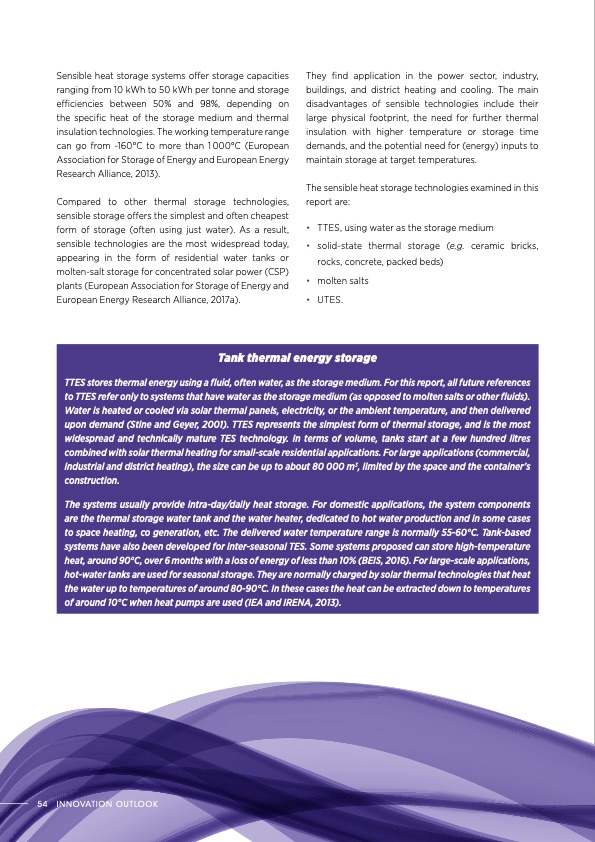
PDF Publication Title:
Text from PDF Page: 054
Sensible heat storage systems offer storage capacities ranging from 10 kWh to 50 kWh per tonne and storage efficiencies between 50% and 98%, depending on the specific heat of the storage medium and thermal insulation technologies. The working temperature range can go from -160°C to more than 1 000°C (European Association for Storage of Energy and European Energy Research Alliance, 2013). Compared to other thermal storage technologies, sensible storage offers the simplest and often cheapest form of storage (often using just water). As a result, sensible technologies are the most widespread today, appearing in the form of residential water tanks or molten-salt storage for concentrated solar power (CSP) plants (European Association for Storage of Energy and European Energy Research Alliance, 2017a). They find application in the power sector, industry, buildings, and district heating and cooling. The main disadvantages of sensible technologies include their large physical footprint, the need for further thermal insulation with higher temperature or storage time demands, and the potential need for (energy) inputs to maintain storage at target temperatures. The sensible heat storage technologies examined in this report are: • TTES, using water as the storage medium • solid-state thermal storage (e.g. ceramic bricks, rocks, concrete, packed beds) • molten salts • UTES. Tank thermal energy storage TTES stores thermal energy using a fluid, often water, as the storage medium. For this report, all future references to TTES refer only to systems that have water as the storage medium (as opposed to molten salts or other fluids). Water is heated or cooled via solar thermal panels, electricity, or the ambient temperature, and then delivered upon demand (Stine and Geyer, 2001). TTES represents the simplest form of thermal storage, and is the most widespread and technically mature TES technology. In terms of volume, tanks start at a few hundred litres combined with solar thermal heating for small-scale residential applications. For large applications (commercial, industrial and district heating), the size can be up to about 80 000 m3, limited by the space and the container’s construction. The systems usually provide intra-day/daily heat storage. For domestic applications, the system components are the thermal storage water tank and the water heater, dedicated to hot water production and in some cases to space heating, co generation, etc. The delivered water temperature range is normally 55-60°C. Tank-based systems have also been developed for inter-seasonal TES. Some systems proposed can store high-temperature heat, around 90°C, over 6 months with a loss of energy of less than 10% (BEIS, 2016). For large-scale applications, hot-water tanks are used for seasonal storage. They are normally charged by solar thermal technologies that heat the water up to temperatures of around 80-90°C. In these cases the heat can be extracted down to temperatures of around 10°C when heat pumps are used (IEA and IRENA, 2013). 54 INNOVATION OUTLOOKPDF Image | THERMAL ENERGY STORAGE Outlook

PDF Search Title:
THERMAL ENERGY STORAGE OutlookOriginal File Name Searched:
IRENA_Innovation_Outlook_TES_2020.pdfDIY PDF Search: Google It | Yahoo | Bing
Turbine and System Plans CAD CAM: Special for this month, any plans are $10,000 for complete Cad/Cam blueprints. License is for one build. Try before you buy a production license. More Info
Waste Heat Power Technology: Organic Rankine Cycle uses waste heat to make electricity, shaft horsepower and cooling. More Info
All Turbine and System Products: Infinity Turbine ORD systems, turbine generator sets, build plans and more to use your waste heat from 30C to 100C. More Info
CO2 Phase Change Demonstrator: CO2 goes supercritical at 30 C. This is a experimental platform which you can use to demonstrate phase change with low heat. Includes integration area for small CO2 turbine, static generator, and more. This can also be used for a GTL Gas to Liquids experimental platform. More Info
Introducing the Infinity Turbine Products Infinity Turbine develops and builds systems for making power from waste heat. It also is working on innovative strategies for storing, making, and deploying energy. More Info
Need Strategy? Use our Consulting and analyst services Infinity Turbine LLC is pleased to announce its consulting and analyst services. We have worked in the renewable energy industry as a researcher, developing sales and markets, along with may inventions and innovations. More Info
Made in USA with Global Energy Millennial Web Engine These pages were made with the Global Energy Web PDF Engine using Filemaker (Claris) software.
Sand Battery Sand and Paraffin for TES Thermo Energy Storage More Info
| CONTACT TEL: 608-238-6001 Email: greg@infinityturbine.com | RSS | AMP |